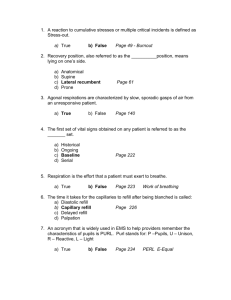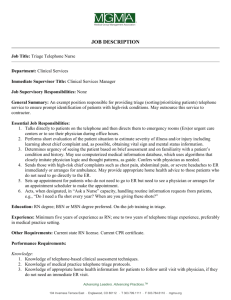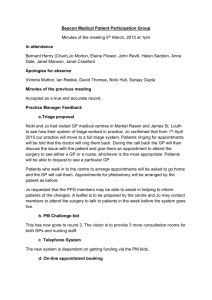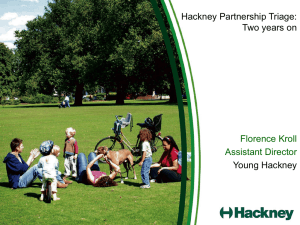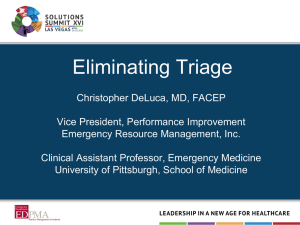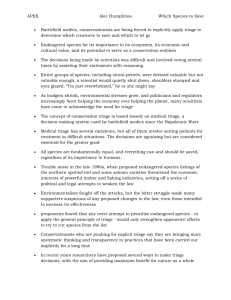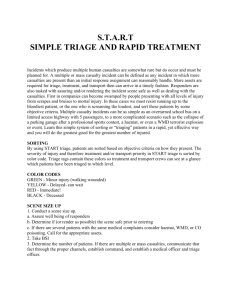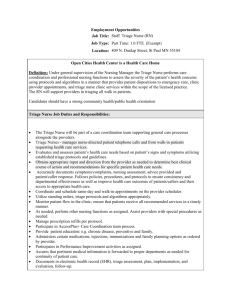START Simple Triage And Rapid Treatment START protocols and
advertisement
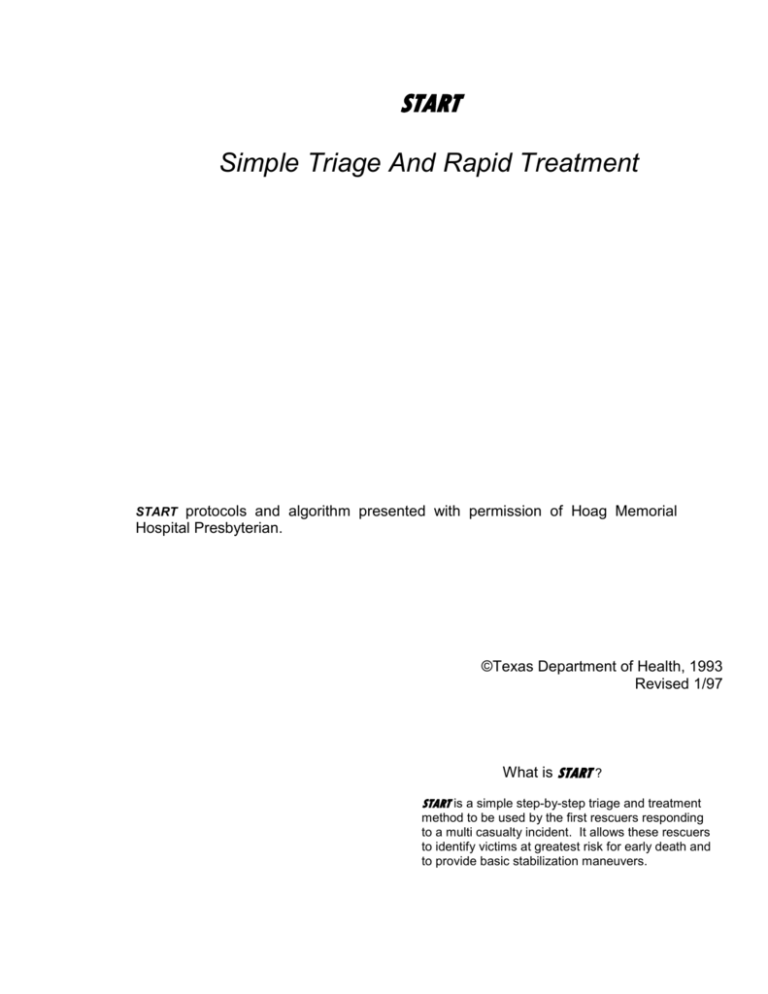
START Simple Triage And Rapid Treatment protocols and algorithm presented with permission of Hoag Memorial Hospital Presbyterian. START ©Texas Department of Health, 1993 Revised 1/97 What is START ? START is a simple step-by-step triage and treatment method to be used by the first rescuers responding to a multi casualty incident. It allows these rescuers to identify victims at greatest risk for early death and to provide basic stabilization maneuvers. START Simple Triage And Rapid Treatment 1 INTRODUCTION Early in 1982 several staff members from Hoag Memorial Hospital Presbyterian in Newport Beach, California, were asked to be observers at a multi casualty incident (MCI) exercise which simulated a bus accident. The first paramedic responders arrived and, after seeing the bus with moulaged bodies lying in and about, started "evaluating" the victims. After a few moments, they approached the Hoag Memorial staff, asking what it was that they should be doing to "triage these victims". It became obvious that no definitive answer existed. Criteria for Initial MCI Triage Which injuries should the paramedics treat • Medically responsible first? ...head injuries? ...penetrating injuries? ..."shocky" victims? ...victims with profuse bleeding? • Easily learned • Easily remembered • Provides clear-cut decision process Who can • Relies only onuse basicSTART skills ? Should the rescuers move quickly through all the victims making some errors? Or, START was designed for first responders whose should they go more slowly, aiming for a emergency medical skills may be at the basic level. higher degree of accuracy? Should they START can also be used by industrial safety begin treatment, or finish the triage first? personnel and hospital technical staff. Nurse and physician groups may also choose to use START as Should they start CPR on the victim who is the first step in their triage systems. in full arrest?...The answers to these questions called for a sensible, orderly triage protocol for MCIs. A search of paramedic training material and medical literature revealed several applicable concepts, but no specific, stepby-step plans for initial MCI triage. To meet the need, the Hoag Memorial staff set about creating such a plan. Their research and experience revealed that an effective initial MCI triage plan must meet certain criteria. 1) It must be medically responsible. 2) It must be easy to learn and easy to retain over a long period of time. 3) It must provide a clear-cut, step-by-step decision process. 4) It must rely on only those skills taught at the basic emergency medical technician (EMT) level. 2 START Simple Triage And Rapid Treatment With these constraints in mind, the group developed the Simple Triage and Rapid Treatment (START) plan. The START plan triages victims who present with simple signs of hypovolemia, respiratory distress, or altered mentation into the immediate group. The remaining victims are triaged into either the delayed group, or the dead/non-salvageable group. In addition, the START plan provides a method for first responders to carry out very simple hemorrhage control and airway protection measures while they triage--the ABCs of basic patient care. The START plan was originally taught over a three hour period to a group of eighty firefighters and paramedics from the Orange County, Newport Beach, and Costa Mesa, California, Fire Departments. Both groups groups triaged more than eighty-five percent of the victims correctly. A small, untrained, control group triaged only twenty percent of the victims appropriately. This exercise demonstrated that the individual discriminations upon which the plan is based can be learned and used by the personnel most likely to be first responders to a mass casualty incident. Following this auspicious beginning, the START plan became an item of intense interest to fire/rescue agencies charged with responding to mass casualty incidents. In 1987, when the State of Texas published the first edition of The State of Texas Multi Casualty Incident Response Planning Guide, START triage was included as the preferred initial triage method for MCIs. As a result, use of the START method increased dramatically in Texas. This course manual and related learning materials are a response to that increase. Here, the original START algorithm is presented just as it was created, while the teaching adaptations give the program a decided Texas accent. It is our sincere hope that you will find this presentation of benefit. START Simple Triage And Rapid Treatment START--Simple Triage And Rapid Treatment--is a system of initial field triage used by first responders at multi casualty incidents START was developed in 1982 by a team of emergency physicians, emergency nurses, and paramedics at Hoag Memorial Hospital Presbyterian in Newport Beach, California. Use of START has spread rapidly. The Texas Department of Health endorses START in its Multi Casualty Incident Response Planning Guide. The 3 START Simple Triage And Rapid Treatment American Society for Testing and Materials includes START in it's Standard Guide for Planning for and Response to a Multiple Casualty Incident. By the end of this three hour course, the student should be able to: Describe the levels of on-scene triage for an MCI (multi casualty incident). Describe the use and purpose of START triage as an initial triage system for an MCI. Describe the use of START triage tags. Rapidly and accurately apply the START triage protocols during a simulated MCI. What is an MCI? Some, including the Texas Department of Health, translate MCI as "multi casualty incident." Others translate MCI as "mass casualty incident." Still others refer to an MVI, a mass, or multiple, victim incident. Finally, in some area a distinction is made between multiple response incidents and multiple casualty incidents. For the purpose of this course, and to lessen confusion, MCI will be translated as "multi casualty incident". However it is translated, MCI refers to any accident or emergency situation that overwhelms local response capabilities. In a rural community, with a small group of volunteer responders, a motor vehicle accident with six victims might be considered an MCI. In any area, a disaster of major proportions is considered an MCI. The determining factor, though, is not the magnitude of the incident, or the number of casualties. The determining factor is whether or not the accident or emergency situation overwhelms local response capabilities. This is because, as local capabilities are exhausted, and mutual aid responders are called upon, the need for a uniform, pre-understood, approach to the incident increases dramatically. To efficiently and effectively manage an overwhelming incident, everyone needs to know what everyone else is doing. Out of this need has grown the concept of Incident Command System, or ICS. An incident command system provides a structured approach to emergency response. Such a system addresses personnel roles, lines of authority, and effective communications. Ideally, an incident command system creates and provides for compatibility and integration of all responding agencies. Firefighters have long used ICS for reponses to both structure fires and wildfires. Now, under OSHA's Hazardous Waste Operations and Emergency Response; Final Rule, ICS is required for responses to incidents involving hazardous materials. With this emphasis on ICS, incident command systems are now being used for all types of emergencies START Simple Triage And Rapid Treatment 4 and disasters, including MCIs. Field triage, therefore, should be compatible with TERTIARY TRIAGE TEAM Follow local protocols to transport victims to appropriate care facilities in order of urgency. Update triage tags as necessary. Assist secondary triage team as needed. any incident command system. TRANSPORT OFFICER Direct tertiary triage team activities. The overall objective of field triage is to accomplish the greatest medical good for the greatest number of victims. Establish & communicate transportation needs. Maintain transportation To achieve thisaccurate objective, field triage is divided into three stages: records. 1) Primary Triage 1. Rapidly assess and tag victims. 2. Render immediate life sustaining care, as necessary. 2) Secondary Triage 1. Document, reassess, and sort patients by treatment needs. 2. Provide medical treatment as appropriate and available. 3) Tertiary Triage 1. Reassess the condition of victims relevant to available resources,transportation, and medical facilities. 2. Determine priority for disposition of victims from the incident site. ICS designates three areas of responsibility for EMS. Although the terminology differs, the ICS designations equate to the traditional stages of field triage. Triage Level Primary Secondary Tertiary ICS Designation Triage Treatment Transport START Simple Triage And Rapid Treatment 5 TRIAGE SECONDARY TEAM Follow local protocols to assess and stabilize victims in order of urgency. Document victim identification and baseline information on triage tags. If necessary, establish treatment areas and sort victims to these areas. Update triage tags as necessary and appropriate. Assist tertiary triage team as needed. TREATMENT OFFICER Direct secondary triage team activities. Report status and transportation needs to transport officer. START Simple Triage And Rapid Treatment 6 Field triage is an on-going process. It begins with the initial contact of a first responder and continues until all victims have been cleared from the scene. Additionally, the speed and accuracy of each successive level of triage depends upon the competent performance of the preceding level. Speed is essential because any process that consumes time also consumes lives. Accuracy is essential because misjudgments cost time and therefore lives. Finally, bringing organization to the chaos is the single most important medical step, resulting in the greatest number of salvaged victims. Thus, a comprehensive field triage system must begin with an effective primary level triage system. And, an effective primary level field triage system must contain four fundamental elements. First, it must be medically responsible. Early trauma deaths are due to disruptions in one, or all, of three bodily systems: the respiratory system, the vascular system, or the central nervous system. To put it simply, trauma victims die in the first hour because: they can't ventilate, they bleed to death, or they have central nervous system injuries so severe that regulation by the brain of breathing and perfusion is lost. Therefore, the victims most in need are those PRIMARY (First Responders) TRIAGE TEAM Execute START initial field triage. Correctly tag all victims unable to walk. Assist secondary & tertiary triage efforts as needed. TRIAGE OFFICER Report initial "size-up" and request additional responders. Brief incoming responders as they arrive. 7 START Simple Triage And Rapid Treatment with significant alterations in one or more of these critical systems. It is not unusual for the original responding crew to be on the scene for ten or even twenty minutes before backup rescuers or resources arrive. In fact, a full hour or more usually elapses before "enough" rescuers and resources have been assembled on the scene. Until enough resources can be assembled for every victim to receive appropriate care, those victims most in need of care must be identified and receive that care, while those who can wait, do wait. First rescuers have the best chance to salvage victims dying of simple airway obstruction or hemorrhage. Also, if victims can be identified by immediacy of need, rescuers arriving later can immediately focus their attention upon those victims most in need of care. Second, it must be rapid. In order to triage and provide life saving assistance to as many victims as possible, the rescuer must limit evaluations to the most significant medical characteristics of the victims that allow an initial categorization. If rescuers spend even five minutes with each of two or three victims, other victims at risk of death in the first ten minutes may be lost. Third, it must be simple: easily taught, easily remembered, easily executed. We cannot predict if, when, or where a disaster will occur. We cannot predict who will be among the initial responding units. But, we can predict that at least some of us will encounter a multi casualty incident. It would be a mistake,however, to spend a great deal of time and money teaching every potential rescuer a plan that he or she will likely use only once, if ever. The first EMT or paramedic crew arriving at a multiple casualty incident is confronted with an overwhelming problem. Their usual response and methods of operating are not applicable. Instantaneously, they must switch to a mode of operation very different from the way they have provided care in the past. These two or three initial rescuers can be faced with 10, 20, 50, 100, or even more victims. The unpredictable turmoil of a disaster setting will rattle even the best memory. Emergency personnel who have responded to disasters say that they never imagined the disaster they encountered. They report feeling overwhelmed and confused. These responders need a simple, step by step, clear cut decision process to fall back upon. It is impossible to predict the skill level of first responders to a multi casualty incident. Therefore any initial triage system must rely on only those skills taught at the most basic emergency care level. Initial triage categorizations must rely upon simple observations already known and used by the potential rescuers, rather than specific diagnoses. Remember, unless a physician is present in the field, diagnoses are not established until the patient reaches the hospital. START Simple Triage And Rapid Treatment 8 Fourth, it must provide for a smooth transition between triage levels. Communication between responders is critical. Precious time can be wasted clarifying needs or repeating steps. This can happen as secondary responders arrive, or as victims are transferred from one area of triage responsibility to another. Additionally, rescuers need a means to chart the course of patient change over time, as well as a means of victim identification. Finally, if victims can be identified from the outset by immediacy of need, rescuers arriving later can focus their first attentions upon those victims most in need of care. It is therefore important that any system of field triage contain an inherent method of continuing communication and record keeping. START Triage incorporates all of these elements. Using START enables first responders to triage victims in 60 seconds or less depending upon only three simple observations. It does not attempt to make diagnoses. It selects victims in greatest need of urgent care based on simple physical assessments regardless of their ultimate diagnoses. It recognizes that there is neither time nor resources available for CPR, blood pressure measurements, or even counting a pulse rate. However, minimal intervention to stabilize the airway or to control hemorrhage is done at the same time as the initial triage. First responders use their time to best advantage by beginning a simple triage and treatment process. Their goal is to move as rapidly as possible through all the victims and determine which need immediate care to prevent death. Victims are identified as "immediate", "delayed", or "non-salvageable/dead", so that rescuers arriving later can immediately focus upon those victims most in need of care. The system uses simplified triage tags which provide a clear, easily recognizable system of continuing communication and record keeping. START TRIAGE TAG The START triage tag consists of three colors: a white body; a red perforated strip; and a yellow perforated strip. These three colors indicate the severity of the injury and the need for care. The rescuer, working from the bottom of the card, tears off the strips that do not apply to the victim and leaves the last color on the tag to identify the victim. The first strip is yellow, signifying "delay" status. Victims assigned to this category will need hospital care, but there is no hurry. They will be transported only after the more critically injured have been stabilized and transported. The second strip is red, signifying "immediate" status. Victims in this category are in the most need of care and/or transportation to a hospital. They should receive attention before all others. Removing both of the strips leaves the white body of the tag. Victims in this category are dead or non-salvageable. These victims, once tagged, should be ignored until all other victims have received care. Normally, some of these 9 START Simple Triage And Rapid Treatment victims might be candidates for CPR. But in a disaster, with many seriously injured victims who might deteriorate without care, CPR should not be attempted. Once a victims's triage status has been determined, the tag can be attached so that it remains visible to other rescue personnel. This will prevent triage steps from being needlessly repeated. The tag allows for updating the victim's status. If continuing retriage determines that the victim's status has deteriorated, the next strip can be torn off. START Simple Triage And Rapid Treatment 10 TRANSPORTATION OFFICER NAME AMBULANCE HOSPITAL PRIORITY 1 2 NAME AGE MALE FEMALE MEDICATION / TIME: 10000 10000 IMMEDIATE 10000 D E L 11 START Simple Triage And Rapid Treatment Left Blank for Anatomical Drawings IMMEDIATE D E 12 START Simple Triage And Rapid Treatment START ALGORITHM START Simple Triage And Rapid Treatment 13 RESPIRATIONS / VENTILATION NONE PRESENT REPOSITION AIRWAY <30 RESP. / MINUTE >30 RESP. / MINUTE ASSESS PERFUSION RED-IMMEDIATE ASSESS RESPIRATIONS / VENTILATION NONE PRESENT WHITE-DEAD RED-IMMEDIATE PERFUSION <> 2 SEC.? NO <2 SEC. ASSESS MENTAL STATUS CONTROL BLEEDING ? RED-IMMEDIATE MENTAL STATUS FOLLOW SIMPLE COMMANDS ? YES NO YELLOW-DELAYED RED-IMMEDIATE APPLYING START YES >2 SEC. 14 START Simple Triage And Rapid Treatment Recall, once again, the goal of the START plan is to rapidly separate all the disaster victims into medical groups according to the severity of their injuries and to provide simple, life saving care. Identify the ambulatory victims. Victims who are able to walk will rarely have life-threatening injuries. Certainly, they do not need care as urgently as those who are unable to walk. The first step, then, is to ask all who can walk to move to a designated area. A simple instruction, such as, "If you can walk, go stand by the large tree," is adequate. (If possible, use an external broadcast system to give this command before exiting the unit. Also, unless there is no other alternative, do not instruct victims to "walk to the ambulance." A group of distraught victims surrounding your unit will interfere with your ability to rapidly address the remaining, non-ambulatory victims.) All victims who follow this command have essentially designated themselves as "walking wounded". This designation will eventually place them in either the non-hospital or the delayed category. Spend no further time with this group. Move immediately to the victims who are unable to walk. You are now ready to apply the three assessments and two treatments of START triage. The assessments are: 1. Is ventilation adequate? 2. Is perfusion adequate? 3. Is the brain injured? The treatments are: 1. Airway maintenance 2. Hemorrhage control "Start where you stand". Then, proceed in an orderly, systematic route through the victims. Assessment and tagging of each victim should take no more than 60 seconds. Do not allow your systematic approach to be disrupted or take too long with one victim. In this way, the greatest number of victims can be screened for urgent, life threatening conditions. Simultaneously, those in most need of care are identified for the second wave of rescuers. Begin with the first START assessment..... "Is ventilation adequate?" Check for respirations. If the victim is not breathing, attempt to reposition or clear the airway. If breathing does not spontaneously 15 START Simple Triage And Rapid Treatment begin, tag the victim dead/non-salvageable (white) and MOVE ON TO THE NEXT VICTIM. Spend no further time with this victim. If the victim is not breathing, but begins to breath upon airway intervention, or clearing, tag the victim immediate. Airway intervention is the most time critical intervention. Additional victims may be salvaged may be salvaged by the simple action of clearing obstructed airways. However, the rescuer cannot waste precious time maintaining one victim's airway. Several methods of airway maintenance may be attempted. Loose dentures, tissue, or foreign bodies can be swept from the mouth. The victim's head may be repositioned with the cervical spine hyperextended. Perhaps, some debris can be used to maintain that position. Or, one of the "walking wounded" might be used to maintain the airway of an unconscious victim. Note that the usual cervical spine precautions may have to be ignored. It is better to open the airway, prop the victim in a new position, and move on to other victims. The sheer number of victims and the urgency for rapid triage and treatment in a mass casualty incident preclude the use of the meticulous spinal stabilization that is used when there is just one, or a few, victims. If neck extension or repositioning is necessary to maintain an airway, then it is done despite the potential risk of worsening a spinal injury. Of course, all victims who require help in maintaining an open airway are classified and tagged immediate. If, when checked for respirations, the victim is breathing, quickly estimate the rate of respirations. Victims with respiration rates greater than 30 respirations per minute are categorized and tagged "immediate". While victims with respiration rates less than 30 respirations per minute are not categorized in this assessment. Thirty respirations per minute is an arbitrary cut-off point. Rescuers do not have time to count respirations, but are expected to estimate the rate. Prepare to estimate respirations by observing others simulate rapid respirations by breathing at a rate of 30 respirations per minute. After a little practice and observation, the difference between 15 and 30 respirations per minute becomes obvious at a glance. If the rescuer is in doubt, the victim should be assigned to the immediate category. (Victims with slow respirations are at risk as well, but slow respiratory rates are almost always due to decreased levels of consciousness which are addressed in the third START assessment.) No further attention is given to the victims in the dead/nonsalvageable category or those already tagged immediate. If a victim is determined to have an adequate respiratory rate, begin the second START assessment... "Is perfusion adequate?" The most sensitive, rapid field method for assessing the adequacy of perfusion is the capillary blanch test. Pressure is placed on the lip or the nail bed and then released. The skin should return to normal color within two seconds if skin perfusion is adequate. (The START Simple Triage And Rapid Treatment 16 rescuer counts, "One thousand-one, one thousand-two," beginning at the time the pressure is released.) If the skin does not return to normal color within two seconds, the victim has signs of inadequate perfusion and should be tagged with a red, immediate, tag. The radial pulse can also be a test for adequate perfusion. This is especially useful in conditions or reduced lighting. In most people, the radial pulse will not be palpable when the systolic blood pressure falls below 80. Therefore, a victim without a readily palpable radial pulse can be assumed to have inadequate perfusion and should be tagged with a red, immediate, tag. Two stabilization maneuvers can be attempted for victims triaged into the immediate group on the basis of inadequate perfusion. First, if possible, pressure should be applied to open wounds, either by the victim or by one of the walking wounded. Second, the victim's legs should be elevated to maximize perfusion of the heart, lungs, and head. (Note: If a victim tagged under the ventilation assessment, who is therefore not assessed for perfusion, has obvious external bleeding, hemorrhage control measures should be undertaken.) If, as a result of the capillary blanch test or the check of the radial pulse, the victim is determined to have adequate perfusion, begin the third, and final, START assessment... "Is the brain injured?" Possible injury to the brain is indicated by altered mental status evidenced by the inability to follow simple directions is used. Ask the victim to open or close his eyes or to squeeze your hand. If this simple command cannot be followed, categorize and tag the victim as immediate. If the victim can respond to simple commands, the central nervous system is assumed to be intact enough to assign this victim to the delay (yellow) category. It should be noted that it is usually possible to skip this assessment because during the earlier assessments and interventions, the rescuer has already had a chance to observe whether or not the victim can follow simple commands. However, this test can be used if doubt remains. SPECIAL CONSIDERATIONS Pediatric trauma victims present some special considerations for triage, but the START system adequately addresses these concerns. START Simple Triage And Rapid Treatment 17 A brief look at normal pediatric respiration rates indicates that using the START decision point of 30 respirations per minute with pediatric patients would result in "over triaging" these victims. This is true, but appropriate. Pediatric trauma victims tend to compensate for their injuries and maintain "normal" vital signs for much longer than older patients. On the other hand, once the ability to compensate is gone, pediatric victims deteriorate rapidly, and often, permanently. NORMAL PEDIATRIC VITAL SIGNS HEART RATE SYSTOLIC BLOOD PRESSURE RESPIRATIONS Newborn 100-160 50-70 30-60 1-6 weeks 100-160 70-95 30-60 6 months 90-120 80-100 25-40 1 year 90-120 80-100 20-30 3 years 80-120 80-110 20-30 6 years 70-120 80-110 18-25 10 years 60-90 90-120 15-20 AGE Source: Seidel,J.S., and Henderson,D.P., Prehospital Care of Pediatric Emergencies, 1987. With children, caution should be exercised when applying the third START assessment, "Is the brain injured?" Younger pediatric victims do not yet have the language skills to understand and respond to simple commands, so impaired mental status must be determined from other clues. An infant that fails to make eye contact with a parent may have impaired mental status. An older child who appears too calm for the circumstance (inappropriate response) may also have impaired mental status. If a rescuer suspects an impaired mental status in a pediatric victim, the child should be placed in the immediate category. Geriatric trauma victims also merit special consideration during field triage. A number of normal aging processes place the elderly at increased risk from trauma. Primary among these risk factors is a diminished ability to compensate for injuries. In many circumstances then, the elderly may deteriorate more rapidly than their younger counterparts. At the same time, geriatric trauma victims may be difficult to definitively evaluate. First, because many elderly experience decreased pain perception, a geriatric victim may not perceive his or her injuries as severe. Or, the geriatric victim may make a conscious decision to simply wait quietly for help, thereby declining to contribute to the confusion while others (especially children) receive aid first. 18 START Simple Triage And Rapid Treatment Additionally, the presence of chronic disease may make it difficult for the rescuer to distinguish between chronic and acute findings. START triage addresses these considerations. Orderly progression through nonambulatory victims ensures that no one is ignored, while the clear-cut assessment process compensates for any difficulty in distinguishing between chronic and acute symptomology. With START the steps are always the same, no matter what type of victim the rescuer is assessing. On this basis, a rescuer can quickly and efficiently triage large numbers of disaster victims. Triage assessments are clearly identified to subsequent rescue personnel. As additional rescuers arrive, they can quickly begin more comprehensive triage, treatment, and re-evaluation, beginning with victims tagged "immediate". Victims may need to be moved to central treatment areas either for safety or for ease of treatment. More extensive stabilization, evaluation, resuscitation, and transport efforts can gradually begin as the necessary personnel and equipment arrive at the scene. The START triage tag can stay with the victim throughout the entire rescue process, even through emergency room admission, providing a continuing record of each victim's condition. The transportation officer can retain the uppermost "tear-off" portion of the tag for inclusion in the transportation log. This simple triage and rapid treatment plan will give you a place to start in the medical management of a multi casualty incident. The START plan is not intended to replace an established incident command system but is flexible enough to be incorporated into any disaster plan. START Simple Triage And Rapid Treatment 19 TRIAGE ASSESSMENT EXERCISE Victim Appart injuries TREATMENT Pertinent information 1 Open fracture, Left femur Respirations, over 30/minute Capillary refill, > 2 sec. Conscious 2 Complains of: Chest pain Shortness of breath Respirations, below 30/minute Capillary refill, < 2 sec. Conscious 3 Second degree burns Over most of body Respirations, none Capillary refill, < 2 sec. Unconscious 4 Facial injury Respirations, over 30/minute Capillary refill, < 2 sec. Conscious 5 Unable to move legs Respirations, below 30/minute Capillary refill, < 2 sec. Conscious 6 No apparent injuries Respirations, below 30/minute Capillary refill, < 2 sec. Conscious 7 Sucking chest wound Respirations, over 30/minute Capillary refill, < 2 sec. Unconscious 8 Dislocated right shoulder Respirations, under 30/minute Capillary refill, < 2 sec. Conscious 9 No visible wounds Respirations, none Capillary refill, > 2 sec. Unconscious 10 Scalp wound, bleeding freely Respirations, over 30/minute Capillary refill, < 2 sec. Conscious 11 Abdominal evisceration Respirations, below 30/minute Capillary refill, > 2 sec. Unconscious 12 Complains of: Severe abdominal Respirations, over 30/minute Capillary refill, < 2 sec. TAG START Simple Triage And Rapid Treatment 20 pain, bruising Conscious 13 Large piece of shrapnel impaled in right eye Respirations, below 30/minute Capillary refill, < 2 sec. Conscious 14 Visibly pregnant, Broken lower leg Respirations, below 30/minute Capillary refill, < 2 sec. Conscious 15 Severe difficulty breathing, chest sinks on inspiration Respirations, over 30/minute Capillary refill, < 2 sec. Conscious 16 Unable to move No verbal response Respirations, below 30/minute Capillary refill, < 2 sec. Conscious and staring 17 Amputated left arm Bleeding controlled Respirations, below 30/minute Capillary refill, < 2 sec. Conscious 18 Large head wound Brain matter showing Respirations, absent Capillary refill, > 2 sec. Unconscious 19 Minor abrasions Respirations, below 30/minute Capillary refill, < 2 sec. Conscious 20 Bruise on forehead Bloody ears and nose Respirations, below 30/minute Capillary refill, < 2 sec. Unconscious 21 Third degree burns covering front of both legs Respirations, below 30/minute Capillary refill, < 2 sec. Conscious 22 Open fracture, Left arm Respirations, below 30/minute Capillary refill, < 2 sec. Conscious 23 Stick impaled in right chest Respirations, below 30/minute Capillary refill, < 2 sec. Conscious 24 Second degree burns Both legs Respirations, over 30/minute Capillary refill, < 2 sec. Conscious 25 Blood in right eye Respirations, below 30/minute Capillary refill, < 2 sec. Conscious 26 Infant (approx. 3 mo.) Respirations, absent START Simple Triage And Rapid Treatment 21 No visible injury Capillary refill, > 2 sec. Unconscious 27 Difficulty breathing Object impaled in abdomen Respirations, over 30/minute Capillary refill, < 2 sec. Conscious 28 Walking around Talking rapidly, repeating "Did you see that," over & over Respirations, below 30/minute Capillary refill, < 2 sec. Conscious 29 Blood spurting from neck injury Respirations, over 30/minute Capillary refill, < 2 sec. Conscious 30 Wearing med-alert bracelet - "diabetic" Skin moist & clammy Feels shaky Respirations, below 30/minute Capillary refill, > 2 sec. Conscious 22 START Simple Triage And Rapid Treatment REFERENCES American Academy of Orthopaedic Surgeons. Emergency care and transportation of the sick and injured. 4th ed. Menasha, WI: George Banta Company; 1987. American Society for Testing and Materials. Standard guide for planning for and response to a multiple casualty incident. In: Annual book of ASTM standards. Philadelphia, PA: ASTM; 1991: vol. 13, p.718-752. Antoline, M. Mass-disaster triage. Jems 6(11):46-48;1981. Bledsoe, B. E.; et al. Brady paramedic emergency care. Englewood Cliffs, NJ: Prentice Hall; 1991. Brownstein, D.; et al., editors. State of Texas pediatric prehospital care: instructor's manual. Austin, TX: Texas Department of Health: 1992. Campbell, J. E. BTLS: Basic prehospital trauma care. Englewood Cliffs, NJ: Prentice Hall; 1988.Fenton, D. EMS specific incident command system. Firehouse (Oct):46-49; 1992. Hafen, B. Q.; Karren, K. J. Prehospital emergency care & crisis intervention. 3rd ed. Englewood, CO: Morton; 1989. Hazmat emergency response improved by implementing incident management. Hazardous Emergency Response. 1(8):1-2; 1992. Le Sher, A.; Feldstein, J. Preparing a hospital emergency room. Health and Environment Digest 5(11):10-12; 1992. Makaris, J. A digest special report: chemical emergency planning and the medical community. Health and Environment Digest 5(11):1-5; 1992. Schroll, R. C. Careful planning, design key to effective emergency response training. Hazmat world (Sept.): 38-40; 1992. Seidel, J. S.; Henderson, D. P. Prehospital care of pediatric emergencies, 1987. Super, G., editor. Start: a triage training module. Newport Beach, CA: Hoag Memorial Hospital Presbyterian; 1984. Texas Department of Health. The state of Texas multi casualty incident response planning guide: generic guidelines. Austin,TX: Texas Department of Health; 1992. Ullman, K. Fire medicine: evaluating field triage decisions. Firehouse. (Sept.):24; 1992. START Simple Triage And Rapid Treatment 23 RELATED TRAINING Available through the Texas Department of Health, Bureau of Emergency Management: • • • • • Incident Command System for EMS Providers Pediatric Pre-Hospital Provider Course Hospital Incident Command System Emergency Medical Dispatch HAZMAT Considerations for EMS Available through the National Forest Service: • Incident Command System Available through private sources: • • Basic Trauma Life Support: Basic Pre-Hospital Trauma Care Pre-Hospital Trauma Life Support


